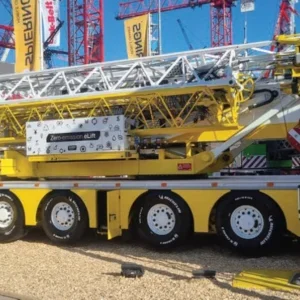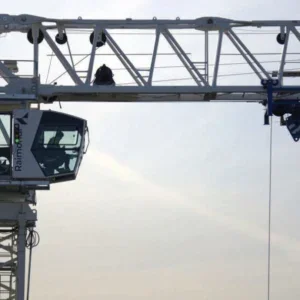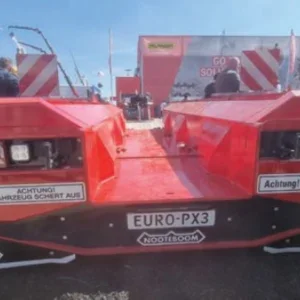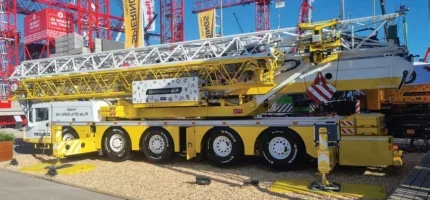
When it comes to the electrification of the mobile crane sector there was a real buzz at the Bauma 2025 tradeshow in Munich, Germany, around new hybrid all terrains, with crane manufacturers Liebherr and Manitowoc both showcasing new models.
The Liebherr crane is the LTM 1150-5.4E. It is a five-axle, 150-tonne capacity mobile crane with a diesel engine and an electric drive. With its integrated battery, the crane can work autonomously for up to four hours without a power connection.
At jobsites with a grid connection this can be a low 16 or 32 amp connection, with the crane’s battery working as a buffer to facilitate full crane performance. The crane draws high current strengths for peaks in performance from the battery which is constantly recharged via the site’s power source. Charging takes place via a CEE high-current plug with 16, 32 or 64 amps and up to 44 kW of power or via a modern CCS plug for fast charging at up to 80 kW.
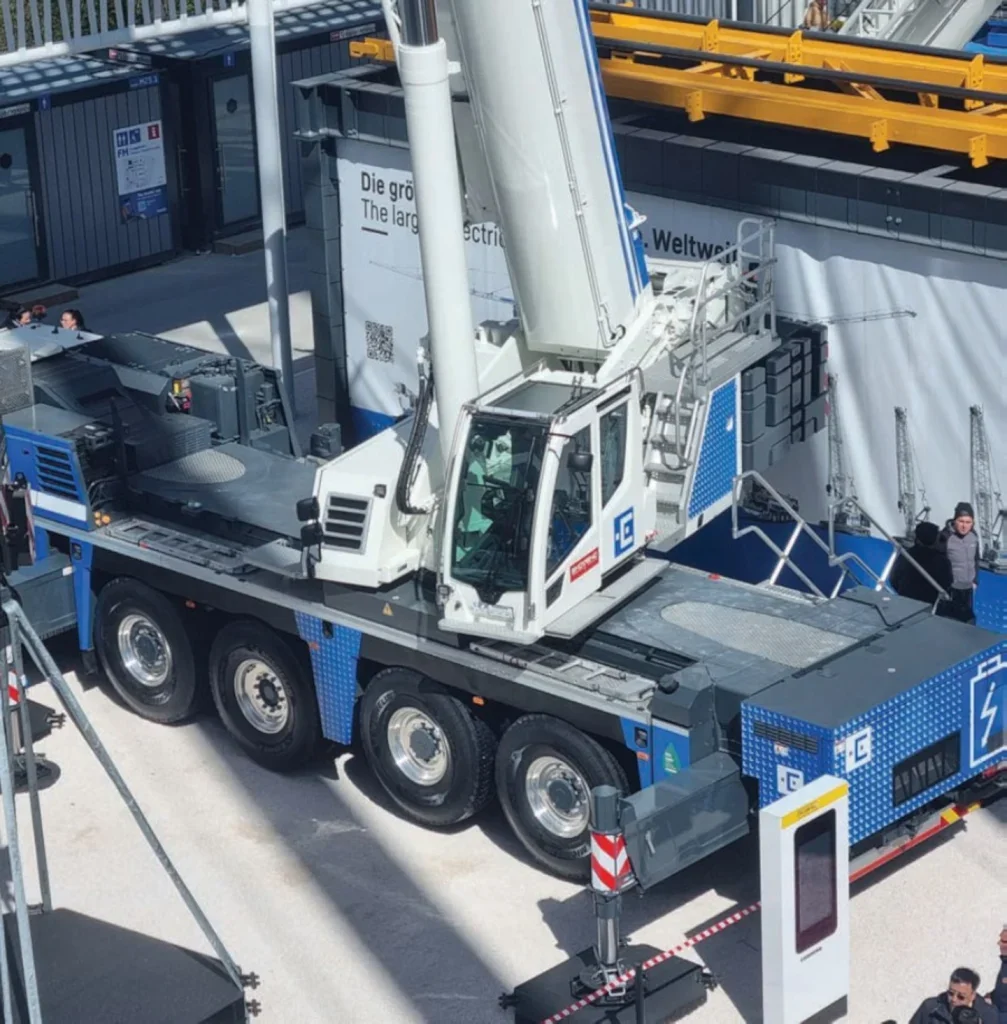
The 99 kWh battery is securely installed in a box weighing around 1.5 tonnes at the rear of the crane. To enable driving on public roads, the ballast plates have been adapted accordingly.
On- and off-road a 400kW (544hp) combustion engine with exhaust emission Stage 5 provides the drive.
The motor is fully compatible with hydrogenated vegetable oil (HVO) and, compared to diesel fuel, reduces operational CO2 emissions by up to 90 percent.
In crane operation users have a choice between using the combustion engine or electric motor. The latter reduces both air and noise emissions and is suitable for zero emissions areas and noisesensitive areas, says Liebherr.
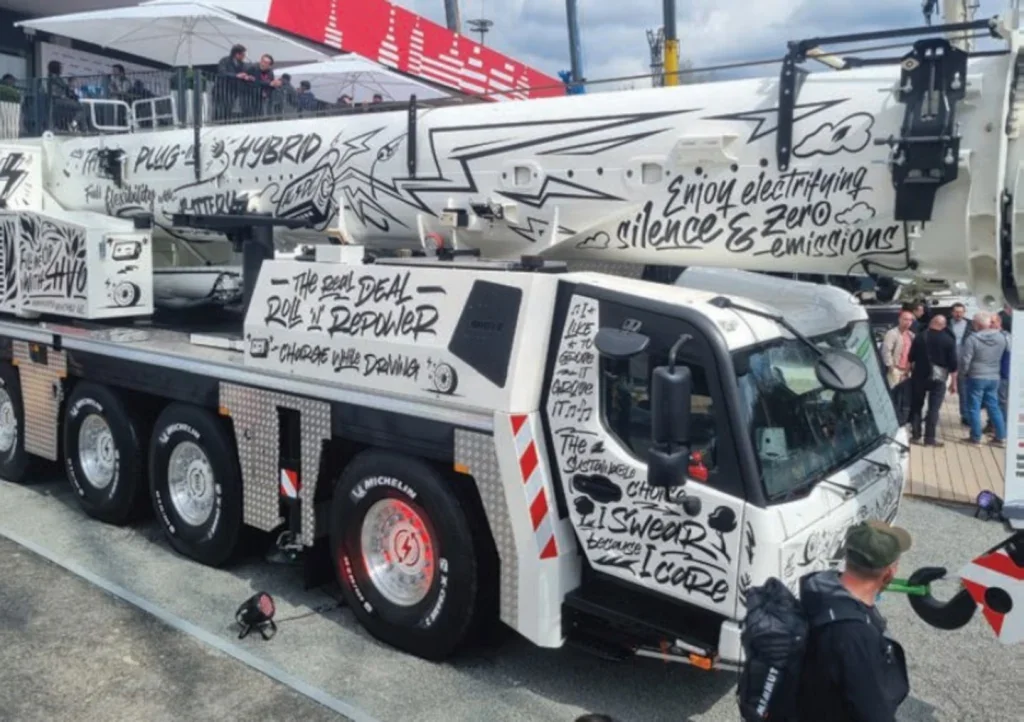
The 111kW electric motor for lifting offers virtually the same performance as the six-cylinder combustion engine as found on its sister model, the diesel LTM 1150-5.4.
For the transfer of power to the consumers in the crane superstructure the electric drive uses the existing gear shafts from the transfer gearbox in the chassis to the pump transfer gearbox in the superstructure.
The electric motor’s distributor gear is integrated between the chassis transfer gearbox and the gear shafts to the superstructure. This facilitates ease of switching between diesel and electric power, says Liebherr.
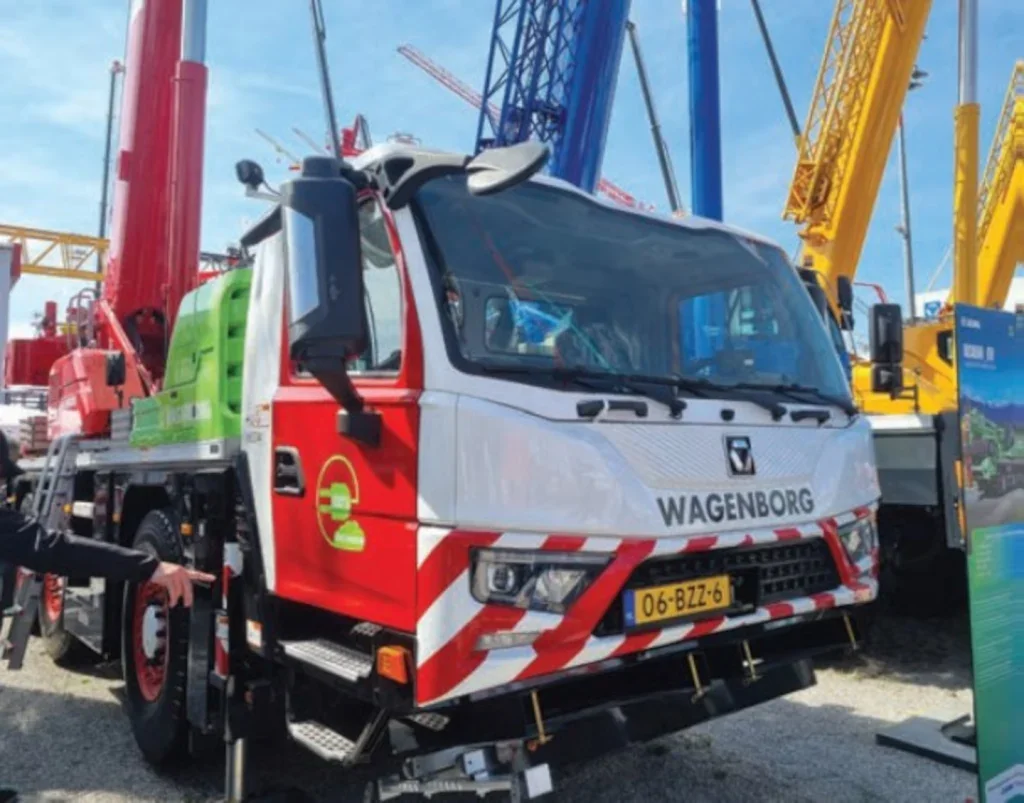
TWICE AS NICE
Manitowoc also used Bauma to launch its ever plug-in hybrid technology all terrain cranes: the 150-tonne capacity Grove GMK5150L-1e and GMK5150XLe.
The cranes incorporate much of the technology that was shown in concept form at Bauma 2022 in the GMK4100L-2 hybrid.
The cranes’ battery pack provides around 180kWh of energy enabling them to provide around five hours work as a taxi crane. The battery can be charged either from the grid (by AC or DC power supplies) or via a 170kW generator integrated into the carrier.
Charging whilst driving or using the crane is possible driving. When the crane is connected to the grid crane operation can be extended to approximately 20 hours without compromising speed or capacity.
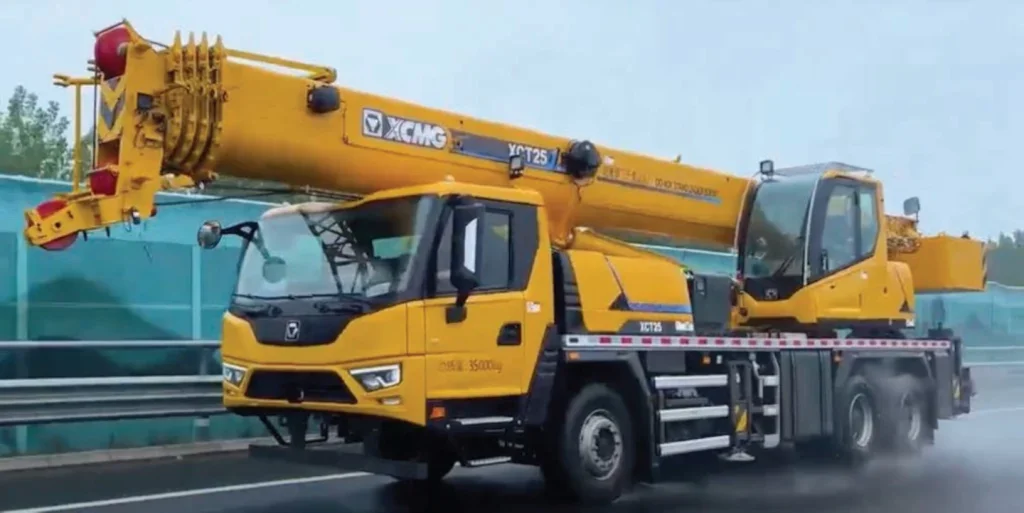
“We certainly believe we have the best overall hybrid crane solution,” says Florian Peters, senior product manager for all terrain cranes at Manitowoc. “We say this because we offer the flexibility to charge the battery pack either from the grid (with either AC or DC supplies) or through the built-in generator, removing any concerns customers have about charging infrastructure.
“So if there is no charging infrastructure at the customer’s depot or on the jobsite, the journey to and from the project can still be used to recharge the 180kWh battery pack.
“The battery pack can accommodate a full working day without any compromise in performance. Even if the crane handles several jobs a day, recharging is unlikely to be required at the jobsite. And if grid charging is available at the jobsite, the crane can operate while being charged.
“When connected to a DC fast charger it takes around an hour to reach a full state of charge. If the internal generator is being used for charging it also takes around an hour to get to 100 percent charge. We should also note that the crane’s diesel engine can also be run on HVO fuel, which offers CO2 emissions reductions of up to 90 percent compared with traditional diesel fuels.
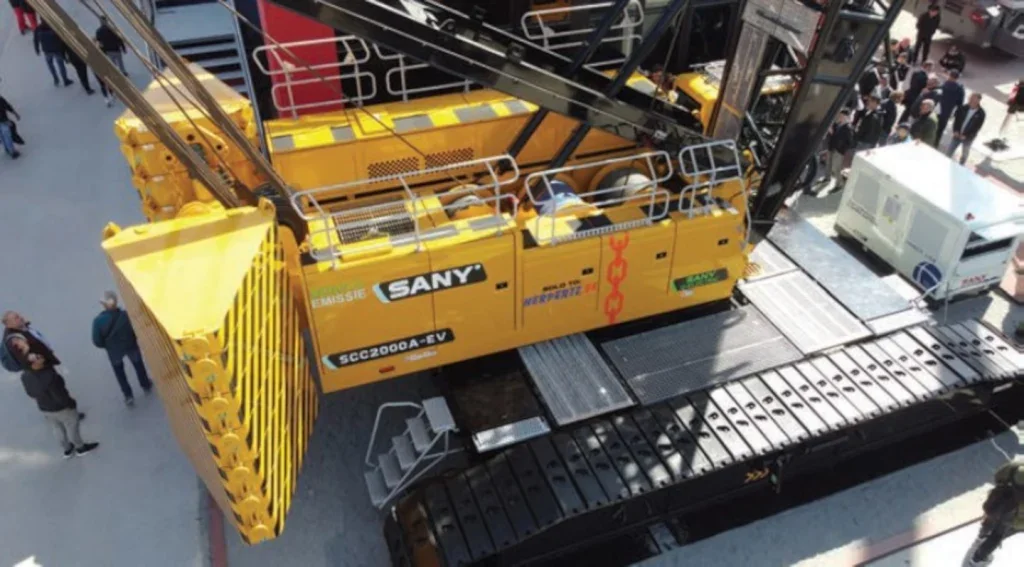
“When connected to 400V/32A power supply, the battery pack can charge overnight and be at 100% by the next morning. The crane can also work while charging with no impact on performance. With a full battery pack and if connected to the grid with a 32A supply, the crane can work for around 20 hours emissions-free. This kind of performance ensures the crane can handle all tasks in a day on even the most demanding jobsites.”
For more on Manitowoc’s new hybrid all terrains see the all terrain crane feature, and interview with Florian Peters, in our April 2025 issue: https://shorturl.at/zEFAd
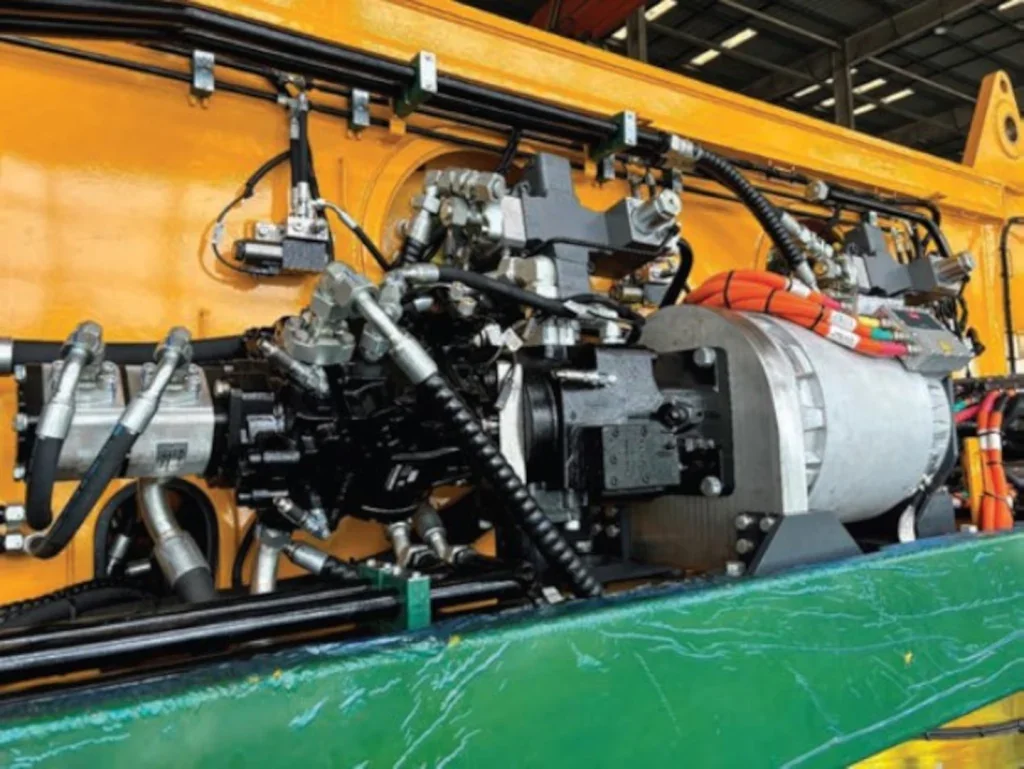
COMING TO THE UK
Another hybrid all terrain on display at Bauma 2025 was the XCA60_EV from Chinese manufacturer XCMG.
The three-axle crane has a maximum lifting capacity of 60 tonnes and its six-section boon has a maximum length of 48 metres, a maximum hoist height of 63 metres, and a maximum radius of 44 metres.
The crane, along with its diesel counterpart – the XCA60_E, is already available in some parts of Europe and North America. They will both become available in the UK later this year.
XCMG claims it as the world’s first hybrid all-terrain crane certified with both CE and WVTA in Europe. It has three working modes: pure electric, pure fuel, and plug-in hybrid.
The hybrid has a 230kw Mercedes diesel engine and a 170kW electric motor which XCMG claims reduces fuel consumption by around 40 percent.
The battery is integrated into the crane’s counterweight.
This hybrid crane recharges its batteries while driving and braking. This means that it can arrive at the site with fully charged batteries so that the operator can get straight to work.
Since Bauma XCMG has also launched a pure electric truck crane: the XCT25G5_1EV. It is an update of the XCT25_ EV which first launched at the end of 2021.
The crane has a 42-metre, five-section boom and a new electro hydraulic control system which XCMG says provides tangible improvements in simultaneous movements and the fine control and smoothness in lifting operations.
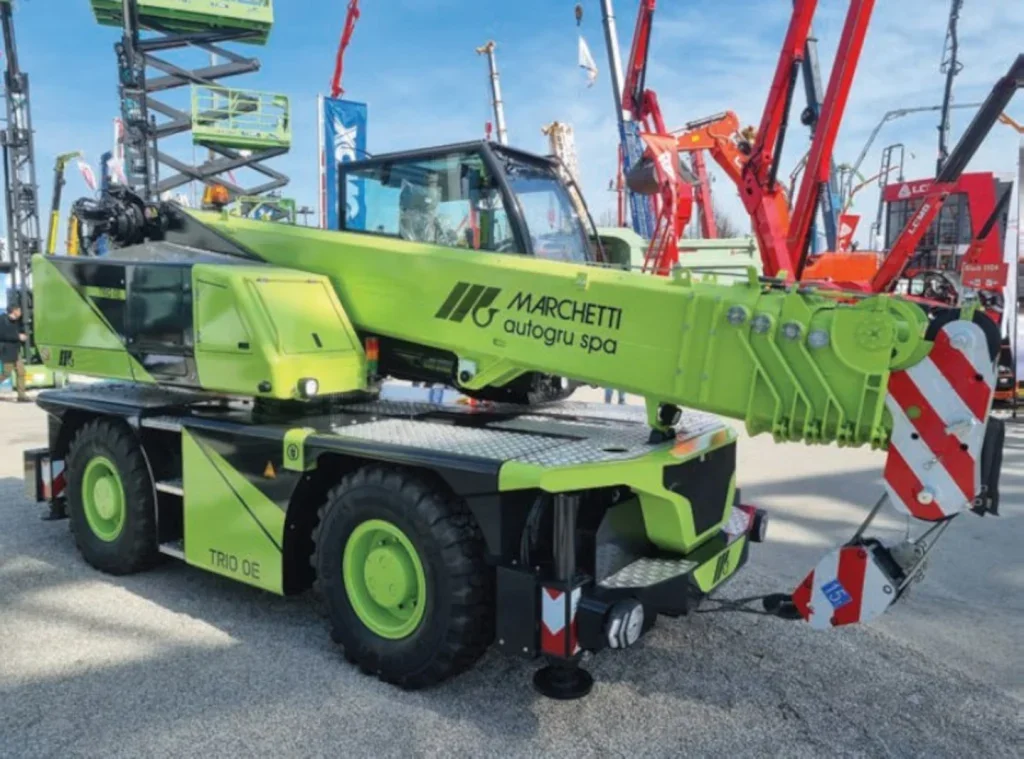
It has a maximum travelling speed of 90km/h and can tackle slopes up to 45 percent.
Acceleration from 0-50km/h has increased by 40 percent on this crane, says XCMG, claiming it feels more like driving a car than a crane.
The driver’s cab includes an air suspension seat, electric heating and cooling and a multi-functional steering wheel, plus a 12-inch LCD instrument panel and 10-inch central control display.
The electric crane is quieter in both driving and operation and can work continually for two shifts under pure electric operation, says XCMG. Charging duration (SOC 30-80 percent) takes just 30 minutes and it can be fast charged using a high voltage connection. A 96.2kWh smart charging unit can be specified. The crane has a waterproof rating of IP68.
A video of the crane can be seen here: www.youtube.com/watch?v=giKLrpKpwhM
Another Chinese company, Sany, had a new large electric crawler crane on its stand: the 200-tonne capacity SCC2000A-EV. It is the first model in Europe and has been sold to Nederweert, Netherlands-based crane and transportation company Herpertz by Sany’s dealer for Europe, Netherlands-based company Sanycranes.services/UCM Holland.
The crane has an 86 metre main boom, a 30 metre fixed jib, a 63 metre luffing jib, and a maximum lifting moment of over 1300 tonne metres.
It is powered by a 422.87kWh high-capacity battery and a motor with a rated power of 234kW, a rated torque of 1118 tonne metres, and a peak torque of 2125 tonne metres. This, Sany claims, offers powerful performance and a runtime exceeding eight hours.
It supports AC/DC multi-mode charging with real time monitoring and protection against overheating, overcurrent and leakage.
It also enables European standard double-gun DC fast charging and can be fully charged in just two hours.
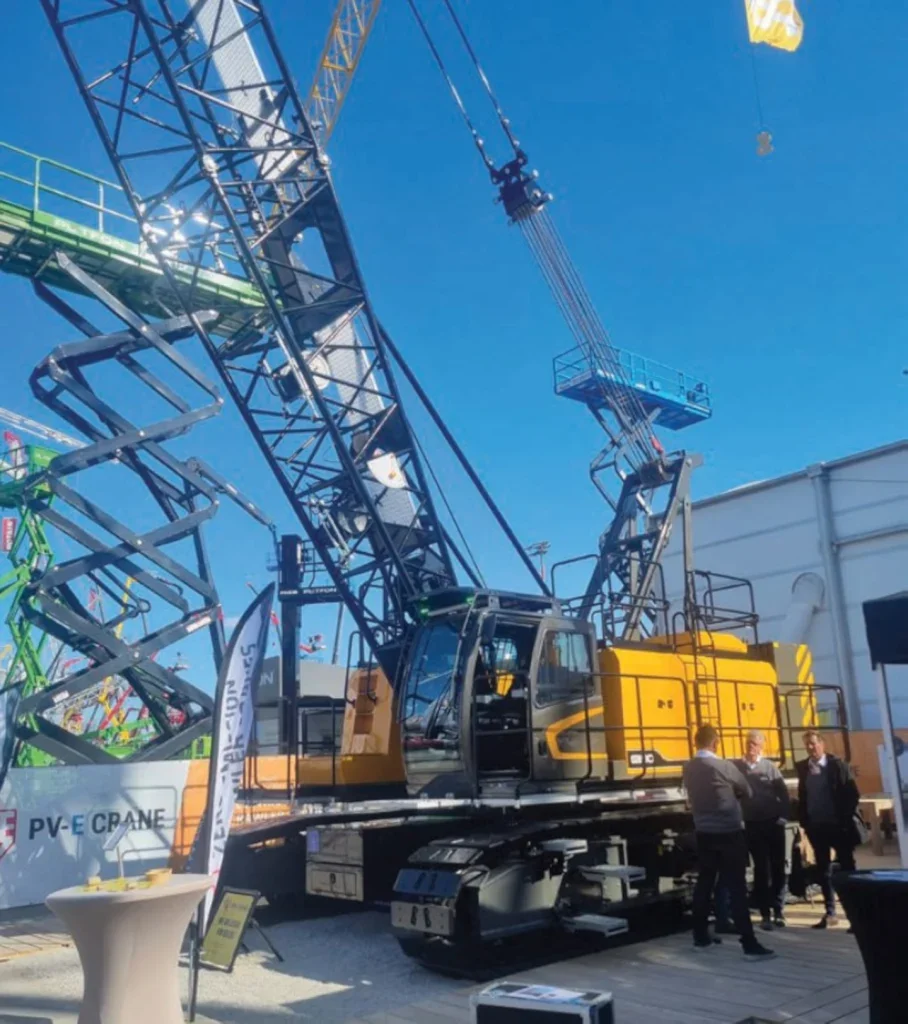
The eco-friendly electric drive also eliminates engine maintenance, adds Sany.
The crane has a working width of 7.5 metres to provide enhanced stability. The crane’s chain type flat track pads are designed to handle sandy, muddy and gravelly conditions, Sany says.
The crane’s battery is from CATL. The hydraulic motor and reducers are from Rexroth. And the electric motor and main valve are from Danfoss. Danfoss Power Solutions’ Editron division delivered its first eHydraulic Power Module for the crane. The eHydraulic system integrates a Danfoss Editron synchronous reluctance assisted permanent magnet motor with a Danfoss variable displacement axial piston pump to maximise performance and efficiency.
Comprising an Editron PMI375-T1100 motor and D1P 260-cc pump, the system is optimised to deliver peak performance and maximise hydraulic system efficiency, says Danfoss, extending machine runtime on a single charge. The full hydraulics system also includes a Danfoss Series 90 pump and PVG 128 valve.
The crane is also equipped with a centralised lubrication system designed for easier and more efficient maintenance.
The SCC2000A-EV can be operated via a wireless remote control system, enabling operators to control crawler travel, lifting operations and outrigger positioning, and rear counterweigh self-assembling.
The crane has a newlydesigned cab equipped with a suspension seat and a dual 10.1-inch smart touchscreen. The screen can supply split views of the surrounding area, winch monitoring, and zoom camera of the boom or jib head (allowing real-time awareness of the equipment’s surroundings).
For enhanced transportability, the boom segments have a ‘threein- one’ transport feature which Sany says greatly lowers transport costs. A YouTube video of the crane can be seen here: www.youtube.com/watch?v=jr5jlhhjxVk
SANY SALES
“We’ve sold 60 new Sany crawler cranes (lattice and telescopic boom) in the last five years,” says Jack Donker from Sanycranes. Services/UCM Holland. Donker has multiple roles at the company encompassing sales and customer liaison to ensuring all paperwork is EU compliant. “We have Sany customers across Benelux, UK, and Poland – those are the main countries we serve,” he continues. “Being in Western Europe our market is mostly electric these days. In the last two years we’ve only sold one diesel model for a customer who wanted to upgrade his Sany Stage 5 diesel crane to an electric model.
“The cranes we have here on the stand are all electric. It’s our main market and being able to supply a portfolio of electric cranes really helps us stand out in the market.”
On the Sanycranes.Services/ UCM Holland stand was a 50t capacity electric telecrawler (bought by foundation specialist Van Thek) and a 200 tonne electric lattice boom crawler (which, like the SCC2000A-EV, had been bought by Herpertz.
“Most of our customers are already on their fifth, or sixth Sany crane – that’s really nice to see,” concludes Donker. “And because there’s not been many electric options in the all terrain crane sector we’ve seen crane companies using electric crawlers instead. In this way the electric crawler market has cut into the mobile crane market a bit.”
CITY CRANE
Another new electric crane on display at Bauma 2025 was the Trio OE Mini City Crane from Italian company Marchetti. It is powered by two rechargable LifePO Lithium batteries. The crane is compact, measuring 6.1metres long, two metres wide, and 2.9 metres high.
It has a hydro-pneumatic suspension system and permanent 4×4 traction for enhanced stability and manoeuvrability. It has a maximum speed of 40km/h
Three steering modes are available (road, concentric and crab). The crane also has a pick and carry mode which allows movement at speeds up to 5 km/h.
The crane has a lifting capacity of 15 tonnes and a total weight of 14 tonnes. The five-section telescopic boom extends from 5.2 to 19.1 metres. It can reach a maximum height of 21 metres.
At Bauma the crane was displayed alongside Marchetti’s electric CW25.35HY 25 tonne capacity battery-powered telescopic crawler crane.
ELECTRIC CRAWLER LINE
Oosterhout, The Netherlandsheadquartered crane manufacturer PV-E Crane used Bauma 2025 to showcase its EC series of electric crawler cranes, represented by the newest model on the stand: the EC90.
The series now comprises the EC80, EC90, EC135, EC160, and EC300 (with the numbers reflecting the cranes’ maximum load capacities). At Bauma PV-E Crane revealed it had already sold an EC90 to a Dutch contractor and said that the range had been well received by potential customers from Europe, USA, Canada and the Middle East.
“What we’ve done is to focus on increasing the quality of our cranes and the technology inside them,” says Joost Bomer, owner at PV-E Crane. “In this way we are positioning ourselves as a premium European electric crane maker.“
The EC series cranes all have new, more spacious cabins that are designed to provide more visibility all-round. In the cab is a large touchscreen display where everything can be read and controlled by the operator, while the cranes’ control joysticks are integrated into the cab’s ergonomic seat. The seat itself includes seat heating and optional massage mode. The seat can be adjusted completely independently of the control levers. The lower screen can be adjusted so that the operator will always be able to reach them well comfortably.
The cranes’ batteries can be charged whilst working via the undercarriage as standard. AC charging and DC charging (fast charging) also come as standard.
The undercarriage has been completely renewed and equipped with elastomer tensioners, while there’s also remote control for wireless operation of the crane during assembly.
“This crane here, for example,” continues Bomer, pointing at the EC90, “is fully CAN Bus controlled and offers a 360-degree camera view, the same quality as you would get in a car.”
The crane control software was developed in conjunction with Da-Tek Engineering.
“All our electric cranes are built from the ground up inhouse in The Netherlands. This enables the freedom for a degree of customisation, if the client requires,” adds Bomer.
ELECTRIC TO DIESEL
In an interesting move, from July 2025, PV-E’s range of EC cranes are available as diesel versions, using clean technology from Cummins. “The reason for this is that the scale of adoption of fully electric cranes has not been as fast and widespread as we initially thought,” explains Bomer. “We have already supplied early adopters and the government is talking a lot about going green but there is no enforcement of this…
“What we are seeing is some contractors bidding on emissionsfree work but then, once they have the contract, they bring in diesel machines. And there is no enforcement of this.
“This has led to a stalling of the market and we see crane buyers undecided between buying an electric model or clean diesel crane. This that led us making the range available as a clean diesel option, for the time being at least.”
The availability of the EC series as clean diesel cranes also appeals to potential USA based customers. “We have received our first preorder from our US dealer Ashland, Virginia-based Atlantic Coast Cranes,” says Bomer.
Last, but by no means least, Dutch company Spierings, a pioneer when it comes to electric cranes, launched a new five- axle eLift mobile self-erecting tower crane at Bauma 2025: the SK1265-AT5 eLift.
Spierings introduced the eLift series in 2020 under a ‘one man, one job’ principle. Thanks to the use of Spierings’ PowerPack technology, eLift cranes can operate fully electrically during daily operations, with a minimum energy requirement of just 16A or 32A. If no power connection is available the crane can operate stand-alone on battery power (hybrid mode). With eLift, you can save up to 85% fuel and still operate at full capacity and speed, says Spierings.
When the battery is low, the generator automatically starts charging the battery. With the automatic start/stop system, fuel consumption is reduced to less than two litres per hour, compared to seven litres per hour for a conventional crane.
By combining operation in 40% electric mode and 60% hybrid mode, the new eLift achieves up to 85% fuel savings. This equates to a reduction of 200.000+ kg of CO2 and offsets 17.000+ trees within 10 years, the company claims.
The crane has a maximum load capacity of ten tonnes (at 13.2 metres) and a tip load of 1.7 tonnes. Jib length is up to 60 metres and the height under jib is 40.5 metres – with a maximum lifting height of 64.2 metres.
Setup is fast at just 11 minutes. The tower can be set up to either 27 or 37 metres while the crane’s jib, with 30-degree capability, can be operated from the crane cabin or via the electrical cabinet.
Spiering’s advanced ballast steering technology facilitates the fast switching between different configurations without the use of an additional crane.
The crane is shod in Michelin X-Crane tyres (445/75 R22.5-inch), while air-conditioning in the crane cab, a steel toolbox at the rear of the truck, 4 steel pads (2.000 x 900 x 76mm) with an auxiliary crane arm and a 30 metre charging cable all come as standard.
Spierings is positive about the current state of demand for electric cranes in Europe. “At Spierings Mobile Cranes, we see a clear and growing demand for electric and sustainable lifting solutions across Europe,” says Herald Wattenberg, commercial director. “We are convinced this trend will only continue to rise in the coming years. That is why we have made a clear choice as a manufacturer: we only manufacture hybrid cranes since end 2023, taking a firm step toward a zero-emission future. The proof is in the pudding as Spierings has delivered over 300 eLift Spierings Cranes till date and each week increasing this number.”
The ‘green machines on display at Bauma demonstrate the breadth of innovation from manufacturers and the rapid rate of progress being made in the electrification of lifting. These next generation cranes show impressive gains in energy efficiency, performance and versatility – with many now capable of operating for full workdays on battery power alone, with fast charging and hybrid helping ease the transition. Although the market still faces challenges, with regulatory uncertainty and inconsistent enforcement slowing the rate of adoption, there remains strong demand in Europe and the continued investment in electrification shows that hybrid and electric cranes are not just a trend; they are shaping the future of lifting.


